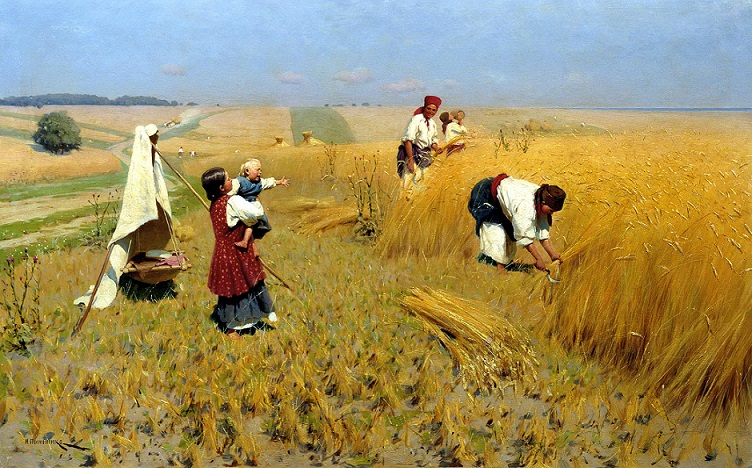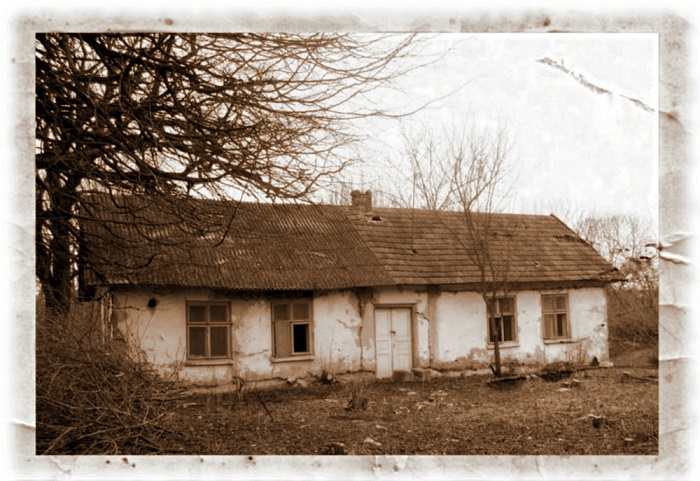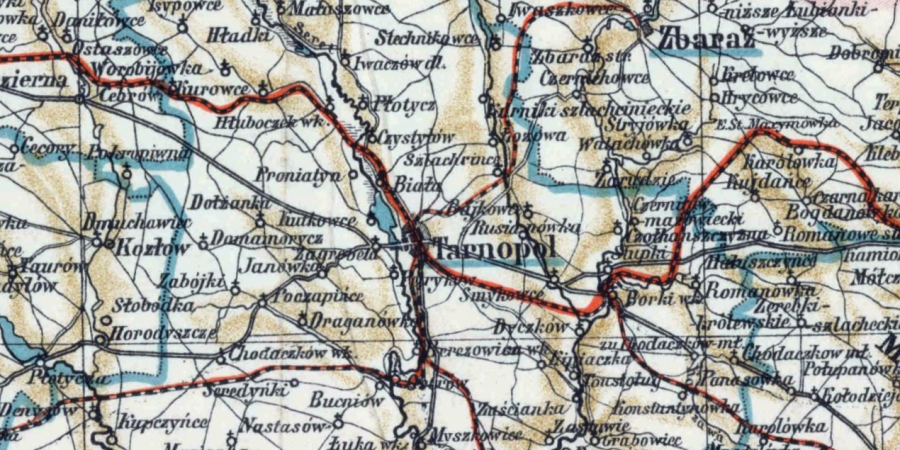A look at early twentieth-century life in Bila (Polish: Biała), a village bordering Ternopil in eastern Galicia. The description is from the autobiography of Katherine Rychly Pylitiuk, who was born in Bila in 1904, grew up there, and immigrated to the United States in 1922. This post is taken from Pauline Noznick’s blog Rooted in Eastern Europe.
***
Sickness was dangerous in Bila, according Katherine Rychly Pylitiuk. Katherine lived in Bila with her mother, two sisters and three brothers. Her father, Sylvester Rychly, was in the United States, working to provide a better life for his family in Bila and hoping to bring them to America. Katherine’s older sisters, Anna and Pauline were in the United States, immigrating in 1913 and 1914. It was difficult to make ends meet in Bila; the family had a farm, but it was too small to support a family of six. The younger children attended school, but everybody had to work so there was food on the table. Since Sylvester was gone, Maria, Katherine’s mother, had a heavy load of responsibility.
The family grew hemp and grain on their land, as well as fruits and vegetables. Hemp was a versatile crop, it grew quickly and could be used for many things. Its fibers were used for rope, and could be woven into a fabric. This fabric was used to make sacks as well as clothing for the family. The grain was ground into flour that provided the family’s bread. Cooking oil was extracted from the seeds.
One of Maria’s responsibilities was to prepare the grain and hemp. Before the grain could be sent to the mill, it had to be cut, and the chaff separated from the seeds. Everybody in the family had to help with the grain harvest. The hemp was cut, bundled and put into the neighboring lake to rot. After several weeks, it was dredged up and cut. The fibers inside of the stalk were removed, combed and sent to the tkach (weaver) to be made into cloth. The women were in charge of cutting the hemp stalks and preparing the fibers. These jobs took a toll on Maria’s health. She developed allergies to the grain and the dust that came with the threshing. The mold associated with the hemp also irritated her. She developed asthma. There was no treatment for asthma except for bed rest, and often Maria was laid up in bed for several weeks.

Maria gave birth to daughter Ksenia in 1908. In the village, women were expected to go back to work after giving birth. She had to take care of the baby and her other small children as well as cooking, cleaning and farm work. This time she never recovered her strength. Her asthma flared up and and she developed pneumonia. She was sick in bed for weeks and the family thought that she might die. The family wrote to Sylvester, who was working in Pennsylvania, asking him to return to Bila. By the time he arrived, Maria was feeling better. He stayed for a several months, then returned to Pennsylvania, but Maria’s asthma continued to affect her health.
In 1913, when Katherine’s youngest brother Onufrey was two years old, he fell into a bucket of “vapno.” Vapno is whitewash, a type of paint made from calcium hydroxide and chalk. It is very effective on surfaces made from clay because it absorbs easily and makes the clay harder. Most of the peasant houses in Galicia, including the Rychly’s, had walls made from clay on a wooden frame, and were painted with whitewash inside and out. Onufrey was sitting on a bench watching his mother mixing the vapno, and while she looked away for a second, he fell head first into the bucket. The ingredients in whitewash can cause serious skin irritation, chemical burns, blindness and lung damage. For Onufrey, the results of this accident stayed with him for the rest of his life. He could not see for the several months after the accident. One eye was larger than the other, and did not focus properly. I remember that one his eye bulged, but I never knew why, or that his vision was impaired. He never saw a doctor for this injury, and was treated with home made remedies.

In 1916, when Katherine was twelve, she and her younger brother Onufrey, who was four, came down with “prypasnytsia,” an illness similar to malaria. World War I was going on around them since they were living on the Eastern Front. Malaria is a disease that comes with war. Today, it exists in tropical areas, but 100 years ago, it was prevalent in many parts of Europe. Since there were soldiers in the village, and they were staying in village homes, it is possible that the disease came with them. It is caused by mosquito bites, and in those days, there was no cure. Its symptoms are a high fever, chills, shivering and fatigue. After six months, Onufrey recovered. However, Katherine was sick for two years. I wondered how this disease could last so long, I found that an affected person can suffer relapses. Since the family was so poor, they were reluctant to see a doctor. But her mother was worried that the Katherine wasn’t getting better, so she went to a pharmacy in Ternopil. It was recommended that she treat Katherine with “kіnova voda,” which means horse’s water. It was prepared by soaking rusty nails in water. Katherine took this “medicine,” which had a bad taste. She recovered eventually. I could find no evidence that iron oxide mixed with water has any effect on malaria.
Illness and injury were often ignored because of the cost of treatment and because the family could not get by without everybody working. Katherine cut her finger harvesting oats. She had to continue cutting the oats because the crop needed to be harvested immediately. Her finger had a serious cut, so it was bandaged and she went back to work. A few days later, the family cow became sick. In those days, sick cows were treated by blood letting. They took the cow to have her blood let, but couldn’t pay the bill. Katherine had to work in the doctor’s field in order to play the bill even though her finger was not healed. Debts had to be paid right away.
When Maria came to the United States in 1923, she was still suffering from the effects of a asthma. Now it was possible for her to see a doctor who could treat her illness, but it was too late. The doctor told her that there was nothing that could be done for her condition. She died on April 12, 1925, at the age of 52. According to her death certificate, the cause of her death was bronchial pneumonia.
See also: Life in the Galician Village of Bila: Crime & Punishment & Life in the Galician Village of Bila: Food
Sources:
Pauline Noznick, “Living in Ukraine 100 Years Ago: Dealing with Sickness and Injury,” Rooted in Eastern Europe (blog) July 12, 2015, http://eeroots.blogspot.com/2015/06/living-in-ukraine-100-years-ago.html
Katherine Pylatiuk and Julia Pylatiuk Lawryk, “Katerina: Kashka. Autobiography by Katherine Pylatiuk Lamar as told to her daughter, Julie in 1988.” Copyright 1988.






This past summer I did a DNA test and wanted to learn about my father’s “Russian” grandparents. My great grandfather was from Hungary per records I’ve come across. He came to the US in 1892. My great grandmother was from Dlugie Malopolskie, Poland and came to the US beginning of July 1894. They were married at the end of July 1894. How they met, I have no clue, but your blog has been a way to learn more about them – thank you!